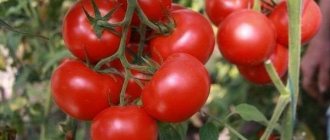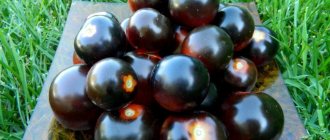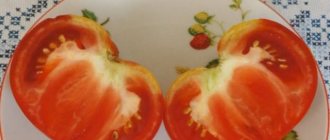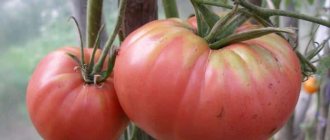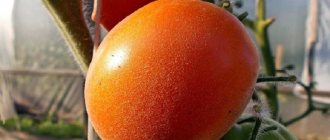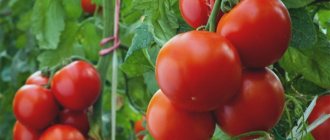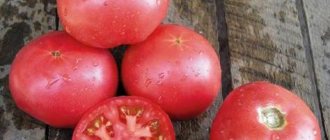A variety for lovers of early harvests
- Fact:
The variety is not too demanding to care for and is resistant to many diseases and weather conditions. - Fact 2:
Tomatoes grow well both under film cover and in the open air. They tolerate temperature changes and lack of moisture well. - Fact 3:
The variety does not lose its taste during heat treatment. Suitable for preparing tomato juices and canning. - Fact 4:
A significant drawback of “Early Love” is its low yield.
“Early Love” is another variety for “lazy” summer residents. It is not too demanding to care for and is resistant to many diseases and weather conditions. Tomatoes are universal in use. Saturated with sugars, acids and vitamins. They make delicious juices, pastes and preparations for the winter.
Description of the variety
The bushes are determinant and have limited growth. The average height of one is about 90 cm. In greenhouse conditions, the figures increase to 2 m. The leaves are similar to potato foliage, medium in size, light green in color. Early love is unpretentious in care and shows good yield indicators.
Distinctive features
The name of the variety speaks for itself: the ripening time of tomatoes is only about 90 days. Tomatoes on clusters set quickly. To get the maximum amount of juicy and ripe tomatoes, the variety is grown mainly in the southern regions of the country. In areas with more severe climatic conditions, the variety is planted in a greenhouse or greenhouse.
Characteristics of tomatoes and yield
Raspberry or red tomatoes have soft and juicy flesh. The weight is small, about 70-100 g. The shape is round, slightly elongated, and has slight ribbing. The skin is dense and velvety. 4-6 tomatoes are tied on one brush at the same time. The yield is average: about 2 kg of tomatoes are harvested from one bush.
Tomato Early love
photo by Valentina Redko
Description and characteristics of the tomato variety Early Love, reviews, photos
An early-ripening, medium-growing, semi-determinate, productive tomato variety for open ground and film shelters.
Bush 0.8-1 meter high, potato-type leaf. The plant does not require pinching, but tying to a support is necessary.
Basic qualities of fruits
The fruits are flat-round, pink in color at maturity, weighing 90-200 grams, sweet and tasty.
These tomatoes are good for fresh consumption, making juices and sauces. Small fruits are suitable for pickling and canning. The Early Love variety, due to its early ripeness, manages to yield the harvest before the onset of late blight. Resistant to fusarium, verticillium, TMV.
Features of cultivation, planting and care
Sowing the seeds of this variety of tomatoes for seedlings is carried out 55-60 days before the intended planting in the ground. Planting scheme for a permanent place in soil 50 x 40 cm, density - up to 6 plants per 1 sq. m.
Tomatoes Early love on video
If you grew Early Love tomatoes, please write whether you liked them or not. What was the yield and taste of the fruits in your climatic conditions? How do you rate the disease resistance of this variety? Briefly describe the advantages and disadvantages of this tomato in your opinion. If possible, attach a photo of the entire bush or individual fruits you grew to your comment. Thank you!
Your reviews of the Early Love tomato and additions to the description will help many gardeners evaluate this variety more objectively and decide whether it is worth planting or not.
How to grow seedlings
Experienced gardeners recommend planting the Early Love tomato in seedlings. This makes it easier for vegetables to take root in the soil and get used to a certain climate. Seedlings are prepared 55-60 days before planting in the ground. You will need soil, a container, seeds, as well as a disinfectant solution and growth stimulants.
Seed preparation
Before planting, the seeds are disinfected and germinated. To disinfect, place them in a cloth bag and soak them in a hydrogen peroxide solution. It will destroy all germs and dangerous bacteria on the surface of the seed. Germination involves placing the treated seeds in slightly damp gauze and placing them in a plate with a small amount of water.
Germination helps the first shoots sprout faster and develop immunity against possible diseases. In addition, this is how gardeners check the quality of the material and the percentage of overall germination. For the most powerful effect, add growth stimulants to the water: the most common of them are “Zircon”, “Silk”, “Epin-extra”.
Important! Aloe juice serves as an organic supplement. The seeds are dipped in juice in a fabric bag and then dried to a loose state. Aloe juice increases the overall germination of seeds by up to 25%.
Container and soil
The soil for seedlings must be nutritious and contain the vitamins necessary for the plant. It is recommended to purchase ready-made soil for seedlings in the store, since the manufacturer will comply with all norms and requirements. But some go the other way and prepare the ground on their own.
For this use:
- soil from the garden;
- humus;
- sawdust;
- peat.
These elements are mixed in a ratio of 4:1:1:1 and placed in the freezer for a day. The cold will kill larvae and pathogens.
After hardening, the soil is taken out and poured into containers for seedlings: plastic cassettes, peat pots, flower pots. All this is sold in gardening stores.
However, to avoid unnecessary expenses, many gardeners use ordinary plastic jars of sour cream or mayonnaise for seedlings. The main thing is to wash them thoroughly, dry them and make small holes at the bottom through which excess water will flow out when watering.
Sowing
Add soil to the container and make small grooves. The ideal distance between them is about 3 cm. Sprouted seeds are placed in the holes, covered with soil on top and thoroughly watered with settled warm water.
It is recommended to cover the top of the seedlings with plastic film or a lid, which is removed only after the first shoots appear.
Growing and care
Place the seedlings in the warmest and brightest place in the house.
If this is a windowsill, then be careful not to allow drafts. Plants should receive at least 15 hours of sunlight per day. If there is less daylight in your region, arrange additional lighting using lamps. The first watering is carried out on the 10th day after planting. Never water the sprouts with cold tap water. Also try to ensure that the water gets mainly under the root, and not on the leaves and stem. To do this, use a pipette or syringe.
The Early Love variety loves feeding, so organize the first one after 15 days. A solution based on onion peels or wood ash is excellent for this. In the future, fertilizing is carried out regularly before planting the seedlings in the ground.
Characteristics of growing tomato love f1
Tomato love f1 is one of the most famous varieties. Tomatoes have the following parameters: excellent taste, high yield, ripening up to 90 days. Even beginners in gardening can grow this variety. Tomato love is not capricious in care. The variety is resistant to diseases.
Description of tomato
Tomato love f1 has bushes up to 1.3 meters. Ninety days pass from planting to the appearance of ripened fruits. It is a mixed species for cultivation in open ground, as well as in a greenhouse. It is highly resistant to cracking. The plant is resistant to diseases and insect attacks.
With excellent care, you can collect no more than 6 kg from one bush. Thanks to proper planting, you can achieve a yield of 20 kg per m2.
A ripe tomato is scarlet or dark crimson in color, rounded in shape, distinguished by a smooth surface, without folds, and a green spot near the stalk. The pulp of tomatoes is quite sugary, but with sourness. One brush includes 5 or 6 large tomatoes. Tomato weight up to 230 grams. The fruits are the same. The advantages of the variety include:
- frost resistance;
- high productivity;
- excellent taste;
- low light resistance;
- tolerance to drought and heat;
- tie perfectly regardless of atmospheric circumstances;
- resistance to stress.
Among the minuses recorded:
- strong support required;
- need for constant feeding;
- Frequent curling and falling of leaves.
Differences from other types
When considering tomato love, you need to pay attention to information on the Internet. There are several varieties of tomatoes that are similar in name:
- "Earthly love." Weight not less than 200 grams;
- "Lover". Tomatoes are also high yielding;
- “My Love” by breeder Myazina has nothing to do with the variety;
- Tomato variety “Early Love” is similar to the Love variety. But their ripening period is different.
Early love variety
Tomato bushes have a height of up to two meters. The first fruits appear ninety days after germination. Inflorescences in racemes, with six ovaries in each. The fruits are spherical in shape and have slight ribbing at the stalk. The skin is strong. When fully ripe, it acquires a bright red or purple color.
On average, a tomato of the Early Love variety weighs 90 grams. The bush produces about two kilograms of ripe fruits. Due to the fact that the fruits have a strong peel, they are easy to store. Can be stored for a couple of weeks. Suitable for transportation over long distances. The fruits do not crack; there are four seed chambers in the cross section.
Cons of tomato early love:
- fruiting at a low level;
- the structure of the branches is weak;
- At the formation stage, tomatoes are capricious about the application of fertilizers.
Sort of earthly love
Earthly love tomatoes are classified as early ripening species. Ripening period is up to 105 days. Tomato bushes are tall. In the garden they grow up to 130 cm, and in the greenhouse up to 150 cm. They have a strong, thick stem. The fruits are red in color and take on a flat, rounded shape with pronounced ribbing. Almost identical fruits grow on one bush. On average, one tomato weighs 230 grams. The pulp of this species is juicy and sweet.
Disadvantages include pinching and gartering and fragility of the stalk.
Planting and ripening of the love variety
The love tomato variety is a mid-early hybrid. Fruiting begins after three months. This is from 105 to 110 days after landing. Sowing is done at the end of March, and seedlings are planted in May. Let's look at how to plant love tomatoes.
Dense planting of bushes is not recommended. When preparing holes, it is necessary to maintain a step of 40 cm in a row between 2 bushes and 70 cm between two rows. Fertilizers are added to the holes, including phosphorus, nitrogen, and potassium.
When the soil is very compacted, you need to add additives to lighten its structure. To do this, add peat and sand. When the acidity level is high, it should not be lowered. Because tomatoes grow well in acidic soil.
Tomato care love
Plants need to be watered every 5 days. The water needs to be defended. It is necessary to monitor the soil moisture. It is better to reschedule watering when the soil has not absorbed water since the last time. You need to water tomatoes in the evening, when the sun has set.
Loosening and weeding are carried out as needed. Most often, operations are performed once every 10 days. It is recommended to remove stepchildren from bushes during the growing season. To avoid damage to the branches, use strong supports. Feeding is carried out up to four times per season. For the normal formation of bushes, it is necessary to use combined mixtures, including potassium and phosphorus, and nitrogen fertilizers.
Recommendations for cultivation
The timing of sowing must be determined taking into account the planting location and climate in the area where your site is located. Cultivation begins with the preparation of seeds for sowing. It is recommended to sort and disinfect self-made seeds. They must be sown to a depth of 2 cm. Then the container with the seeds must be covered with film and taken to a place where the temperature is 25 C. In March, it is advisable to illuminate with fluorescent lamps so that the total daylight hours are approximately 14-16 hours. Incandescent lamps are prohibited.
In the phase of 2 true leaves, it is recommended to plant seedlings in cassettes or glasses. The need for seedlings to fertilize depends on the soil and partly on the temperature in the greenhouse. Extracts from humus and Fertik are suitable fertilizers. Before planting, hardening at 14 C is recommended.
Before planting, it is recommended to add a bucket of compost, a glass of ash and 25 grams of superphosphate per 1 m2. Up to 5 plants are planted per meter.
Tomato diseases love
The variety is resistant to a number of diseases, but it is worth carrying out prevention. Ventilate the greenhouse from time to time to reduce the possibility of fungal diseases. A balanced solar and watering regime is recommended. In case of illness, it is necessary to use the drug "Hom".
Don't forget to remove the affected fruits. It is worth fighting the Colorado potato beetle. Use chemicals (for example, "Prestige"). Sometimes the plant is affected by black spot (a disease caused by the aerobic, gram-negative bacterium Xanthomonas campestris).
On the outer side of the leaf, grayish-brown, rounded spots appear over time, darkening over time, from 5-6 to 14-16 mm in diameter. “Fitolavin” will help against illness. To prevent the appearance of rottenness, they are treated with calcium nitrate. At the same time, it is worth reducing the amount of watering.
Collection and saving
The fruits are harvested immediately after ripeness. The delay threatens rapid spoilage of the vegetable. You can remove green fruits from the bushes. Ripening takes place within a month. There is no need to be afraid of picking off ripe tomatoes: they are easily transported without damaging the shells.
Store vegetables at temperatures from +14 to +16 C in a well-ventilated area. Free air flows prevent fruit spoilage. It is necessary to regularly re-sort vegetables so that rottenness does not pass from tomato to tomato. Good fruit safety is guaranteed by freezing. The only disadvantage of this method is the change in taste.
Reviews
Inna: “For several years in a row I have been giving preference directly to the Lyubov variety tomatoes. And I can’t get enough of my own harvest. One bush produces up to 6 fruits. The taste is rich and sweet. Diseases must be fought with pharmaceuticals or folk recipes. Therefore, I can recommend it as one of the best varieties of tomatoes.”
Elena: “I have been looking for the best varieties of tomato for a long time. The love variety was recommended by a neighbor. Fruit ripening is surprisingly fast. I collect up to 6 kg from a bush. To prevent various diseases, after moving the bushes to a permanent place, they are treated with the substance “Fitosporin”. If symptoms of the disease occur, the infected bushes must be eliminated by throwing them outside the garden. The fruits are very tasty and last a very long time. Before this, my family mainly preferred Cherry, but these tomatoes replaced them. And it’s not so difficult to grow them, water them more, tie them up. You can plant, but the harvest will be smaller. But the tomatoes themselves will be large in size. I recommend it to gardeners and even beginners in growing crops.”
How to grow tomatoes
The process of growing the variety is simple and does not require special knowledge and skills. A huge advantage of Early Love is that the tomato does not form stepsons and does not need garters. Let us consider further what exactly is needed to obtain a good harvest.
Landing
Tomatoes are planted only in beds prepared in advance. Choose the lightest and warmest area in your garden for the vegetable. Dig it up, remove all debris, and water it with a solution of potassium permanganate. This will disinfect the soil.
Tomatoes are planted in beds, leaving a distance of about 50 cm between the bushes. If the planting is done more densely, the tomatoes will not have enough space for root development and nutrition. The sprouts are transferred to the soil with a lump of earth on the roots. Be careful not to break young and immature seedlings.
Care
Proper care is as follows:
- Regular watering. Carried out every 8 days. To prevent diseases, a tea-based solution or garlic mixture is sometimes added to the water. This reduces the risk of fungi and infections. It is recommended to water Early Love with rain or melt water. Do not over-moisten the soil: excess moisture leads to cracking of tomatoes and loss of taste.
- Removing weeds . Foreign plants disrupt the metabolism in the bushes, which leads to their wilting. Especially a lot of weeds appear after rains and fogs. It is important to remove them every 7-10 days.
- Loosening the soil provides oxygen access to the plant. Sawdust or river sand are used as a natural leavening agent.
- Fertilizing bushes . Feed the bushes every 2 weeks. To do this, use nitrogen-containing preparations or organic matter. For example, ammonium nitrate or liquid bird droppings are excellent food for tomatoes.
Features and possible difficulties
When growing, gardeners are faced with some nuances. For example, an excess of nitrogen-containing fertilizers. Sometimes the desire to feed the crop leads to disastrous results.
The fact is that a large amount of nitrogen stimulates the development of green mass, which slows down the ripening of fruits. Therefore, the first fertilizing should not contain nitrogen; give preference to organic fertilizers.
In addition, never water tomatoes from above, on the leaves. This should be done at the root, and then carefully loosen the soil around the bushes. The ideal time for watering is early morning or evening. 2-3 liters of water is enough per bush. Focus on the weather: if it's a hot or rainy summer, reduce the amount of water.
Important! During the flowering period, tomatoes’ “appetite” increases sharply, so they need abundant watering based on balanced fertilizers.
Diseases and pests
Tomatoes have high immunity to diseases, but some of them still manage to “attack” Early Love.
First of all, we are talking about fungal diseases:
- Late blight manifests itself in the form of brown spots on the leaves and is accompanied by wilting of the bushes. To combat it, the drugs “Quadris” and “Fundazol” are used.
- Septoria looks like white spots with a brown rim and appears as a result of improper care and high humidity. An excellent remedy for it is a solution of Bordeaux mixture.
- Alternaria blight destroys leaves, stems and fruits. Infection usually occurs through the soil. It appears in the form of small spots that increase over time.
The most common insect pests on tomatoes are spider mites and aphids. The mite entangles the leaves with a white cobweb, which causes metabolic failure in the latter.
For preventative purposes, spray the bushes with whey. Aphids are small white insects that accumulate in colonies on bushes. To prevent it, plants are sprayed with a solution of copper sulfate.
Tomato Love F1: a good hybrid for any purpose
Tomato Lyubov F1 is one of many representatives of modern hybrids that is not difficult to grow. The plant is easy to care for, and the tasty and beautiful fruits will satisfy the needs of the most demanding gardener. This hybrid is accompanied mainly by only positive reviews from gardeners.
Description of the tomato variety Lyubov
Tomato Love is the development of Yuri Ivanovich Pantchev, who mainly deals with tomatoes and peppers. The hybrid was registered in the State Register of Breeding Achievements of the Russian Federation in 2006 and is intended for planting in any region. It is recommended for personal subsidiary plots and other small-scale farms; it is grown both in unprotected soil and under film covers: depending on the climate of the region, one or the other option is more suitable.
The Lyubov tomato is a determinate variety, but the bush, especially in a greenhouse, can grow quite tall - more than a meter. Therefore, plant formation and stem tying are necessary procedures.
The leaves are green and of normal size. The first flower cluster is formed after the seventh or eighth leaf, the next ones after one or two. 5-6 tomatoes are formed in the brush.
In terms of harvest ripening, the tomato is mid-season. The tomatoes are medium-sized, weighing 50–75 g, regular round in shape, with barely noticeable ribbing. No cracking is observed. When ripe, they are colored red and contain 4 or more seed nests. The taste is rated excellent. The main use is for salads, but the shape and size of the tomatoes allow them to be preserved as a whole.
Hybrid tomatoes Lyubov F1 - regular round shape
The yield of the hybrid is average, just over 5 kg/m2. It has increased resistance to diseases, especially resistant to verticillium and fusarium. No cracking of the fruits was observed even in damp weather or when left on the bushes.
Features of the Lyubov F1 hybrid from different manufacturers
Seeds of the hybrid Lyubov F1 are produced by different companies. The data indicated on the bags may differ slightly from that provided in the State Register of Breeding Achievements of the Russian Federation. For example, it claims that the hybrid is early ripening and the first fruits ripen within 100 days after sowing, and weigh 200–250 g, although most of the information on the packaging is true. in a similar situation, he reports that the yield of the hybrid is four (!) times higher than that declared by the author and stated in the official document. Therefore, the video below should be treated with skepticism.
Video: advertising of tomato seeds Lyubov F1, which does not correspond to the information in the State Register of Breeding Achievements of the Russian Federation
Advantages and disadvantages
There are quite a lot of varieties and hybrids of tomatoes similar to the one under consideration; it is nothing outstanding, but, like any modern hybrid, it has many more advantages than disadvantages.
The fruits of the Love tomato are ordinary small red balls
The advantages of the Love tomato are:
- excellent presentation of the fruit;
- evenness of tomatoes, i.e. all tomatoes are approximately the same size;
- good transportability;
- no cracking under any conditions;
- good drought resistance;
- increased resistance to diseases;
- excellent taste, not always typical for tomatoes of this shape and size;
- versatility of application.
Among the disadvantages of the hybrid, they note the not very good yield, which strongly depends on the fertility of the soil, as well as the need for the formation and staking of bushes, which can be dispensed with for many determinate varieties.
Differences from other varieties
When considering the Love tomato, you need to be very careful and critical of the information provided on the Internet. And this is not only a matter of malicious intent, but often also of carelessness: there are several varieties of tomatoes with similar names:
- Earthly love by the same author, bearing fruit with tomatoes weighing at least 200 g;
- Lyubushka: this variety has a high yield, but the taste of fresh fruit is rated only as good;
- hybrid My Love by breeder L.A. Myazina, which has nothing to do with the tomato in question;
- Novosibirsk variety Early Love, most of the indicators of which, with the exception of the ripening period, are similar to those of the Lyubov tomato.
Photo gallery: tomato varieties with names similar to Lyubov
Features of planting and growing the Lyubov tomato
Agricultural technology of the Lyubov tomato has no obvious characteristics; it is grown similarly to many other determinate varieties of medium ripening. Sowing seeds directly into a garden bed is possible only in the southernmost regions, but even there, with this technology, it will be possible to get fruits only in the second half of summer. Therefore, usually the seedling stage is not neglected; seeds are sown in boxes at the usual time - around mid-March or a little later. For greenhouse cultivation, seeds are sown at the very beginning of spring.
Caring for seedlings is usual: you must not miss the moment of the appearance of the very first shoots in order to move the box to a well-lit, cool place and keep it there for up to a week. Subsequently, the seedlings are kept at room temperature, and picking is carried out at the stage of two true leaves. The humidity regime is normal, it is advisable to do without fertilizing.
Tomato seedlings Lyubov grow normally, and the bushes are of average size before planting in the garden
Seedlings are planted in a garden bed with the onset of warm weather: in the middle zone at the very beginning of summer (in a greenhouse - depending on its quality). The planting density is average, the optimal pattern is 40x70 cm. Plant care is standard. The soil is often loosened or kept under a good layer of mulch.
Despite the fact that this hybrid is not subject to cracking of the fruits, as they begin to ripen, watering is significantly reduced so that the tomatoes gain sugar: the Lyubov tomato is not afraid of drought, but many experienced gardeners note excessive sourness in the taste of the fruit.
It is reported that three standard fertilizers are not enough for this tomato: after fruit set, the plants are fed every two weeks, mainly using mullein infusions with the addition of wood ash. The hybrid's resistance to disease is high, but in those regions where late blight is often observed, preventive treatments with copper-containing preparations are necessary.
Most often, this tomato is grown in two stems: a strong stepson located under the first flower cluster is chosen as the second. The remaining stepsons, as they appear and reach a length of 4–5 cm, are systematically broken out. At first, the bush does not need to be tied up, but as soon as the tomatoes begin to gain weight, tying up the stems in several places is necessary. There is no need to tie the brushes separately: they are not so heavy as to break the shoots.
Tomato bushes Lyubov grow according to one of the traditional patterns, usually in two stems
Reviews of the hybrid Love
Due to the ambiguity of the name, it turns out that the number of reviews specifically about the Lyubov F1 hybrid is very small.
I would like to share my impression of one of my favorite tomatoes - the hybrid Lyubov F1. The fact that the tomato is determinate is a big plus for me, since a tomato tree will not grow. When growing it, I don’t bother it at all; it grows as it wants. Of course, I feed it, spray it with a solution of boric acid (1 g per 1 l) during flowering, tie it up, and pick off unnecessary leaves. Moderate watering at the root. Phytophthora does not occur in a greenhouse. The hybrid is declared as early, but this year it began to turn brown at the end of July.
Novikova Maria, Smolensk region
The nuances of growing in open ground and greenhouses
In open ground, tomatoes are grown after legumes, onions, and cucumbers.
Summer residents do not recommend planting tomatoes after potatoes, eggplants or peppers. The location of the tomato bed is changed every year. Monitor the acidity of the open ground: lime will help against its excess. The rate of lime fertilizers depends on the composition of the soil. It is best to form the beds from east to west, so the earth will warm up faster. The holes are placed in straight rows or in a checkerboard pattern.
Before planting in the greenhouse, the beds are prepared 10 days before planting. The soil is loosened and humus is added. If the soil is infertile, then charcoal is added. Loamy or sandy loam compounds are best suited for tomatoes.
You can’t plant tomatoes in cold soil; you need to warm it up first. The optimal temperature is about 15 degrees. It is better to plant early in the morning in pre-moistened soil.
Prevention of diseases and pests
Although the My Love hybrid is characterized by increased resistance to disease, it is sometimes affected by phomosis (bacterial spotting) and blossom end rot. In the first case, HOM and Fitolavin are used for treatment, and in the second case, calcium nitrate is used.
To prevent diseases, seeds are warmed up before planting, watering is moderate, and the greenhouse is regularly ventilated. In the fall, the remains of former plants are burned and the ground is dug up.
The most serious damage to the crop is caused by Colorado potato beetles, whiteflies, mole crickets, and cutworms. Special insecticides are used against them (Prestige, Grom, Confidor and others). For prevention, before planting, seeds are disinfected with potassium permanganate or a mixture of 50 g of aloe juice, 0.5 tsp. honey, a couple of drops of garlic juice and an immunostimulant.
A week after diving into open ground, the plants are treated with a weakly concentrated mixture of boric acid and potassium permanganate.
Another means of prevention is a tincture of nettle, wood ash and horsetail, mixed with a small amount of garlic. The bushes are sprayed with it once a week.
Harvesting and application
The return of Early Love is gradual, so tomatoes are harvested as they ripen. Pick carefully without damaging the stem. Make sure that the vegetables do not overripe. For storage, place in a cool place where the tomatoes “reach” the stage of 100% ripeness.
The range of uses for tomatoes is incredibly wide. The product is used in the preparation of first and second courses, side dishes and salads, appetizers, tomato juice and even desserts. For example, the well-known recipe for tomatoes in caramel with ice cream has won the hearts of many chefs.
Early love has a sweet-sour taste that harmoniously complements meat or poultry. Chefs love to use vegetables for stuffing or stewing. Many people make sun-dried tomatoes or preparations for the winter.
Advantages and disadvantages of the variety
The variety Early Love is loved by many because of its merits:
- ease of care;
- early ripeness;
- juicy taste;
- versatility in application;
- attractive appearance.
However, tomato also has a number of disadvantages:
- average yield;
- the plant is capricious to fertilizers during growth;
- in the northern regions of the country it is suitable only for greenhouse conditions or under film.
The original variety with “chocolate” fruits - Kumato tomato: characteristics and description
The Kumato tomato is known among tomato lovers and collectors, but it is not grown en masse. It can be planted in your own summer cottage to get a harvest of original dark fruits containing many useful substances. They have a sweet, pleasant taste and are universally used.
| Height | Landing location | Ripening time | Fruit color | Fruit size | Origin | Fruit shape |
| Tall | Greenhouse | Mid-early | Bicolor | Average | Variety | Round |
Description and characteristics of the variety
The Kumato cherry variety was created by Swiss specialists from the Syngenta company. They put into it the genes of the Olmec tomato, as well as a wild variety and blackberries. The latter provide tomatoes with an unusual color, as well as a berry aroma and taste.
Tomato bushes are indeterminate, grow up to 1.8-2 m. The plant is very heat-loving, so it prefers a greenhouse.
Regular type sheet. The fruits grow in clusters of up to 8 pieces each. Medium early ripening - about 110 days after the first shoots.
The shape of the fruit is round, weight - from 100 to 150 g. Color varies from burgundy to dark burgundy or burgundy brown. Sometimes it can be so dark that the variety is called black. The pulp is very sweet, with a berry flavor and aroma, excellent taste. The purpose is mainly for fresh consumption, but you can use the fruits for other culinary purposes and even make jam from them.
Advantages and disadvantages
- original and pleasant taste and smell;
- beautiful coloring of fruits;
- excellent yield;
- high content of valuable substances;
- quite early ripening;
- resistance to late blight, alternaria, mosaic and many other diseases.
Minuses:
requires comfortable greenhouse conditions.
Landing
Seedlings are sown in mid or late March. To obtain healthy seedlings, prepare the following materials:
- The soil is made from garden soil with the addition of humus and peat, sand for drainage and wood ash to normalize acidity. For 10 kg of mixture add 2 tsp. mineral fertilizer with nitrogen, for example superphosphate.
- If the soil is prepared independently, it is disinfected by freezing, calcining in an oven or spilling with a solution of potassium permanganate.
- Seeds also require disinfection in a one percent solution of potassium permanganate or Fitosporin. After this, they are washed and soaked in a stimulant solution. You can replace both procedures with aloe juice treatment.
- Disinfect containers for seedlings.
The soil is laid out in boxes and the grains are planted in grooves placed 3 cm from each other. Sprout them by moistening them well and covering them with film. Before germination, heat is required up to +30 degrees. When the seeds sprout, the temperature is immediately reduced to +16. After another three days, a constant regime is established: about +18 degrees at night and +22 during the day.
Seedlings are illuminated for at least 12 hours a day, and preferably 14 hours. If the sunny day is shorter, turn on the lamps.
Harden off before transplanting. An area is prepared in the greenhouse, replacing the top layer of soil at least 7 cm. All surfaces are disinfected.
The depth of the holes should be at least 25 cm. Before digging, fertilizer with phosphorus is applied to the soil. For 1 sq. m there are from 2 to 4 bushes.
Growing and care
It is not recommended to water seedlings in a permanent place in the first week. Water is added to the holes only when planting. Watering at this time will make the root system shallow, which will weaken the bush. In the future, water regularly once a week, but if necessary, less or more often. Do not wet the leaves and stems with water, or apply it in direct sunlight. The optimal time is evening. The water is heated or kept in the sun during the day.
After watering, loosen the soil. Inspect the stems regularly and spud them when aerial roots appear.
Form bushes into 2 stems and attach them to supports. When the plant blooms, the lower leaves are cut off under the tassels in several approaches.
Feed at least three times a season. First, nitrogen fertilizers are used - organic matter, urea, saltpeter. Young bushes can be watered with a solution of bird droppings or manure. With the beginning of flowering, they are transferred to mineral complexes with potassium and phosphorus.
Farmer reviews
There are both positive and not so positive reviews about the Early Love variety online.
Galina, Volgograd: “I love varieties that do not require a lot of attention.
My garden is located outside the city, I can’t go there every day. That’s why I chose the Early Love variety a couple of years ago. He did not disappoint me, the vegetables grow tasty and juicy. I especially like to preserve them for the winter.” Marina, Orsk: “A friend recommended this variety to me. Overall, I was pleased with the harvest, especially that the tomatoes were neat and beautiful. During the entire ripening period, I sprayed it with a whey solution, and all diseases avoided the bushes.”
Olga, Kurgan region: “I plant at least five different varieties on the plot every year. So last year the Early Love tomatoes turned out to be the worst. I waited a long time for the ovary, although the variety positions itself as early ripening. I didn’t like the taste.”
Prevention of diseases and pests
“My Love” has very good resistance to many diseases, so if you follow all care and prevention measures, diseases will be avoided.
Plantings may be attacked by pests - the Colorado potato beetle, aphids, thrips and spider mites. Insecticides will help get rid of them.
The “My Love” tomato is suitable for beginner gardeners without the slightest experience, since there are no difficulties in care other than following simple rules. Good luck to you and good harvests.
If you find an error, please highlight a piece of text and press Ctrl Enter.
In addition to diseases, plants can be attacked by pests: slugs, cutworms, aphids. Insects are destroyed with garlic infusion (200 g of grated garlic or onion per 10 liters of water).
Chemicals are also used in pest control:
- "Karate";
- "Meta";
- "Decis";
- "Storm".
To get rid of slugs, red pepper, crushed eggshells, and pine needle mulch are sprinkled around the bushes.
The tomato variety “Earthly Love” has very good resistance to many diseases, so if you follow all care measures and
, diseases will not affect you.
It is equally important to have an understanding of such tomato diseases as Alternaria, Fusarium, Verticillium, and late blight. Also on our website you will find information about protection against late blight and about varieties that are not susceptible to this scourge.
As for pests, the Colorado potato beetle, aphids, thrips, spider mites and slugs most often attack tomatoes. Proper soil care and mulching will help prevent their occurrence.
With little effort you can get a very good result, this is exactly what this hybrid variety is about. Caring for it will not be difficult; even an inexperienced gardener can handle it. Good luck to you in the new season.
Most often, “Love” suffers from the following ailments:
- Fomoz. If symptoms are detected, the affected fruits are removed and the plants are treated with the fungicide “Hom”;
- Black spot. The drug “Fitolavin” showed a good effect against spotting;
- Apex rot. Occurs when the soil is waterlogged. When a disease appears, the plant is treated with a solution of calcium nitrate.
Of the pests, the Colorado potato beetle causes the greatest damage to plantings. In small areas, beetles are collected by hand. On large plantations the insecticide "Prestige" is used.
Tags: love, description, detailed, variety, tomato, characteristics About the author: admin4ik
